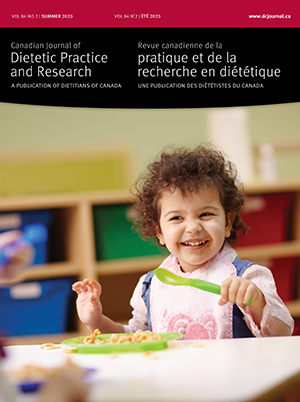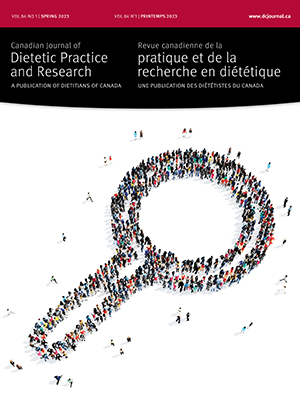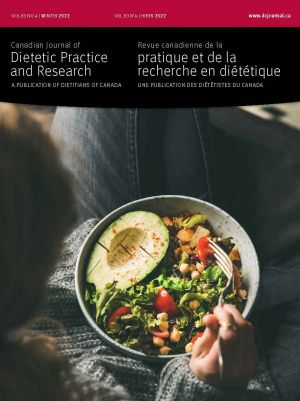Volume 69 • Number 3 • September 2008
Chair’s Message
Editor’s Message
Research
Purpose: A telephone survey was conducted to determine dietitians’ views on nutraceuticals and functional foods. Methods: Using systematic sampling with a random start, 238 names were drawn from the Dietitians of Canada membership. A survey instrument containing mostly open-ended questions and two pages of definitions was pretested and revised. Accurate description was used to analyze and summarize the data with a minimum of interpretation. Results: Of 180 dietitians contacted, 151 (84%) completed interviews. The majority (n=91, 60%) of respondents thought health claims should be permitted on foods, but only with adequate scientific support for claims and government regulation. Participants overwhelmingly (n=122, 81%) felt that dietitians were the most appropriate professionals to recommend functional foods, but held mixed views of the appropriateness of having dietitians recommend nutraceuticals. However, according to a rating scale of 0 to 10, respondents across all areas of practice believed that it is extremely important for dietitians to become knowledgeable about nutraceuticals (mean ± standard deviation [SD] = 9.0 ± 1.2) and functional foods (mean ± SD = 9.5 ± 0.9). Conclusions: Dietitians recommended strict legislation and close monitoring by government; unbiased scientific studies with consensus that the findings support health claims; partnerships with other health professionals, especially pharmacists; and opportunities to gain further knowledge.
Purpose: Various societal influences have shaped the way dietetic students view and react to current educational situations. Students’ perspectives were sought on conditions that caused stress in the educational environment, what they thought educators did not understand about them, and changes their faculty or preceptors had made to address their needs. Methods: Third- and fourth-year university students, interns in their final rotations, and master’s degree students completed a questionnaire (n=284). Results: Several stressors were identified: thinking about getting a job as a dietitian, lack of finances or debt, competing for internship positions, the ability to meet program demands, and envisioning the area in which they would specialize. The qualitative analysis highlighted gaps in understanding between students and educators. Gaps concerned student finances, the evaluation process, inflexible undergraduate and internship structures, competition among students, ineffective communication, and finding a balance between academics and other competing interests. Conclusions: A conflict exists between what students expect as part of their educational experience and what they actually experience. Students appreciated educators who engaged them in the learning process and recognized the realities of their lives.
Objectif: Mesurer et analyser le lien entre le stress perçu et le comportement alimentaire d’étudiants de première (Ét1) et de quatrième année (Ét4) à l’Université de Moncton au début (T1) et à la fin (T2) du trimestre universitaire. Méthodes: Quatre-vingt-quatorze sujets de divers programmes universitaires ont participé à l’étude. Le stress perçu a été mesuré à l’aide de la Perceived Stress Scale, la consommation alimentaire par un journal alimentaire de trois jours et la fréquence de consommation alimentaire par un questionnaire de fréquence. Résultats: Au début du trimestre, les Ét1 et Ét4 présentent un niveau de stress faible. Au T2, le stress perçu des Ét4 augmente significativement (22,3±1,4; p=0,005). Le profil alimentaire mesuré selon le niveau de conformité au Guide alimentaire canadien pour manger sainement montre, avec l’accroissement du stress, une augmentation de la consommation de lait et produits laitiers (p=0,05) chez les Ét1,T1 et de produits céréaliers (p=0,02) chez les Ét4,T2. Une corrélation négative significative est observée chez les Ét4 entre le stress perçu et l’ingestion de thiamine (r=–0,48, p=0,006) et de zinc (r=–0,42, p=0,02). Aucune corrélation n’est observée entre le stress, l’apport en calories et la consommation des autres nutriments étudiés. Conclusion: Ces résultats révèlent l’importance d’intervenir auprès des étudiants universitaires et d’implanter des sessions d’information favorisant la gestion du stress et l’adoption de comportements alimentaires sains.
Report
Purpose: Prince Edward Island adolescents’ food use was examined, as were possible associations between food use and grade, sex, and academic performance. Methods: Participants (n=325) were purposively selected from four junior high schools. Dietary data were collected using an adaptation of the 2003 Youth Risk Behavior Survey. Demographic information and self-reported academic performance were also assessed. Vegetable and fruit (VF) and milk scores were created, and multivariate analysis was performed to identify which combination of grade, sex, VF score, and milk score predicted academic performance best. Results: Mean daily intakes of VF (4.3 ± 2.9 servings) and milk (1.7 ± 1.4 servings) were below recommended levels. Students with higher academic performance (average grades above 90%) were more likely to consume milk, vegetables, and fruit daily than were those who reported lower grades. There was no significant difference in the proportion of adequate milk intakes between students reporting higher and lower academic performance. Conclusions: The association between VF intake and academic performance supports the need for further research with a larger, more representative sample.
Purpose: The treatment of celiac disease is a strict gluten-free diet for life. This diet is assumed to be more expensive, although no studies confirm this assumption. In the current study, the prices of gluten-free foods and regular (gluten-containing) foods were compared to determine if and to what extent gluten-free products are more expensive. Methods: Prices were compared for all food products labelled “gluten-free” and comparable gluten-containing food items in the same group available at two large-chain general grocery stores. The unit cost of each food, calculated as the price in dollars per 100 grams of each product, was calculated for purposes of comparison. Results: All 56 gluten-free products were more expensive than regular products. The mean (± standard deviation) unit price for gluten-free products was $1.71 (± 0.93) compared with $0.61 (± 0.38) for regular products (p<0.0001). On average, gluten-free products were 242% more expensive than regular products (± 212; range, 5% to 1,000%). Conclusions: All the commercially available products labelled gluten-free were significantly more expensive than comparable products. This information will be useful to dietitians who counsel individuals and families with celiac disease, and to celiac advocacy groups for lobbying the government about financial compensation.
Purpose: Food consumption was investigated in children attending three elementary schools in urban Hamilton, Ontario. Methods: Dietary data were collected from 92 children in grades 2 to 4 through 24-hour dietary recalls (39% participation rate). Servings of four food groups were compared with recommended daily servings in Canada’s Food Guide. Results: The majority of students did not consume the recommended five daily servings of vegetables and fruit. On average, they consumed a high number of servings of “other foods,” which were not included in the four food groups. More than 50% of the students did not consume the recommended daily servings of milk products, and only a small proportion (21%) drank milk during school lunch. Conclusions: We recommend that primary school educators promote the consumption of vegetables and fruits and milk products at school, either through healthy snack programs or educational programs.
Recognition
OPEN ACCESS
The health and well-being of individuals and the prosperity of the country require a well-nourished population. Canadians face unprecedented challenges to the goal of healthy eating and physical activity. The challenges are complex and dietitians have a collective responsibility to respond as thoughtful, competent practitioners. As we embrace the future, we need to understand our past and reflect on how we will create a future that will support nutritional health and well-being for all Canadians. Dietitians, in partnership with others, must play a key role.










